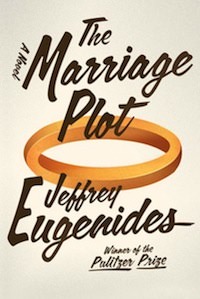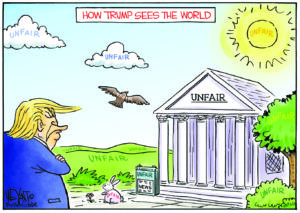In Sickness and in Health
Pulitzer Prize winner Jeffrey Eugenides' third novel, "The Marriage Plot," set in 1982 at Brown University, is his attempt to "traffic in the same ideas" as Jane Austen and Henry James, with some social satire and meta-fiction mixed in.
“The Marriage Plot” A book by Jeffrey Eugenides
When is a novel based on the marriage plot not a novel based on the marriage plot? When the female protagonist is a semiotics student.
Jeffrey Eugenides’ new novel, “The Marriage Plot,” begins in 1982 at Brown University. It centers around a romantic triangle involving three college students: Madeleine, an English major studying semiotics; Mitchell, a religious scholar who travels to India to work in Mother Teresa’s Home for the Dying Destitutes—a character Eugenides says is partly based on his own youthful self; and Leonard, a genius philosophy/biology student suffering from bipolar disorder who Eugenides insists is not based on David Foster Wallace (more on that later).
Eugenides has clearly taken the title’s subject matter seriously, but at the same time he seems embarrassed by the fact that he’s doing so. Perhaps we can blame his education for that; he studied semiotics in college as well.
In a recent NPR interview Eugenides said, “I envy writers who came from a world where social constrictions were still normative and they could still write marriage plots. I couldn’t, being an American born in 1960. … I didn’t think it was possible to write a Jane Austen novel now, and in fact, it isn’t. But I did want to traffic in the same ideas.” Huh. The chick-lit writers have been writing marriage plots all along, and seem to be doing so with some success. I suspect Austen, were she alive today, might even consider herself a chick-lit author.
However, given Eugenides’ belief, you have to give him an admiring pat on the back for attempting a contemporary, or should I say postmodern, version. But Eugenides has never been one to shy away from a challenge. His first novel, “The Virgin Suicides,” was the story of five suicidal girls and incorporated the first-person-collective point of view. For all of that, I found the book appealing and clever. His second book, the much-lauded “Middlesex,” for which he won a Pulitzer, I found less successful, although I accept I may be in the minority on this one. Perhaps the problem lay in Eugenides’ point of view in “Middlesex.” That book is narrated by Cal Stephanides, a hermaphrodite who tells the story of his/her incestuous grandparents and parents and takes us from war-torn Turkey to Detroit to Berlin, to Ford factories and the birth of the Nation of Islam—as I said, the ambitions are grand. But of course there is a problem with having a first person narrator tell the story of other people—the narrator can’t really know what’s going on in other people’s heads, can’t really overhear conversations that happened before he was born, can’t realistically describe every detail of events at which he wasn’t present. I’m all for breaking rules if it works, but for me this didn’t quite work. Just as I was getting involved in the lives and emotions of the characters, up popped Cal again, commenting on things he/she couldn’t possibly know. It felt like authorial intrusion and reminded me only of the limitations of the first person point of view. It was a clever device, in a look-at-how-terrific-a-writer-I-am sort of way, but for me it detracted from the story.
With this new book, Eugenides switches points of view between the three main characters—Madeleine, Leonard and Mitchell—and with each new section the plot takes one step forward, then retraces its steps a wee bit to explain how we got to where we are now. It’s a lovely rhythm and keeps the reader’s interest.
There are three ways a reader can approach “The Marriage Plot”:
1) As a love story
2) As a satire or social criticism, à la Tom Wolfe
3) As a meta-fiction
The book succeeds as a love story, albeit an unconventional, terribly self-aware love story, almost in spite of itself. Leonard and Mitchell are both well-drawn characters with complex inner worlds, desires and conflicts. Madeleine is less fully realized, but her intellectual life provides the thematic focus. As an English major at a university where semiotics and deconstruction are all the rage, she is writing her honors thesis on “the marriage plot” — the traditional plot device of novels by writers such as Austen, Henry James and George Eliot. She feels as out of step in her academic ambitions as Eugenides apparently felt in his desire to write this sort of book. According to the academic wisdom of the day, after all, narrative is old-fashioned and language, with its elusive meanings, is not to be trusted. Goodbye Charles Dickens; hello Jacques Derrida. Madeleine is also becoming cynical and skeptical of romance, but at the same time, she’s falling in love with Leonard, a brilliant, dangerously complicated man.
Mitchell Grammaticus, mystical religious seeker, is in love with Madeleine, while at the same time yearning for a deeper connection with God. He sits cross-legged on the quad, repeating “The Jesus Prayer”: Lord Jesus Christ, have mercy on me, a sinner. He hopes to repeat it so often his heart will begin to pray by itself.
Leonard, although terribly charismatic and something of a romantic legend on campus, is obsessed less with any other human being than he is with his own mental health, and with good reason. The wild mood swings have begun to take their toll. He ends up hospitalized, heavily medicated on lithium and profoundly depressed.
I do have to mention here that although Eugenides insists Leonard is merely a composite of many people he’s known, and is not, absolutely not, modeled after David Foster Wallace, I had to work extremely hard throughout the entire novel not to compare Leonard to DFW. They were both brilliant, mentally ill, obsessive-compulsives. They were both more than 6 feet tall, wore Timberland boots, kept their chewing tobacco in their socks (when not chain smoking), and yes, they both wore bandannas around their heads. I will take Eugenides at his word that he did not set out to exploit Wallace for his novel but, especially after Wallace committed suicide in 2008 and so many in the literary community were talking about it, surely someone—editor, publisher or agent—must have seen the glaring similarities and suggested the author tweak a few details. Mentally ill? Sure, but maybe he could wear some other trademark item, be of a different body type? Something? I found it increasingly difficult to read about Leonard’s sour mouth, his infected hair follicles, his acne, his hemorrhoids, his sexual dysfunction, because I couldn’t get Wallace out of my head, and it seemed wrong to stare so. But, back to the story. In the early part of the novel, when all three are still ensconced in university, some of the conversations between Zipperstein, the semiotics professor, and his students, as well as some of the descriptive passages are delightfully funny. Consider this description of Zipperstein:
Becoming a semiotician allowed Zipperstein to wear a leather jacket, to fly off to Douglas Sirk retrospectives in Vancouver, and to get all the sexy waifs in his classes. Instead of leaving his wife, Zipperstein had left the English department. Instead of buying a sports car, he’d bought deconstruction.
Great stuff, and this is where the novel flirts at being a sort of social commentary, poking wonderful fun at the highly rarified atmosphere of college campuses and the sort of pointless, absurdist, all night conversations young people have during those years of intellectual and existential angst.
It is in this atmosphere Madeleine decides she loves Leonard, no matter how alarming his illness. They move to Cape Cod, where he has won a prestigious science fellowship, and where she has little to do but care for him. Leonard, heavily drugged, struggles with the work, and fears that his affliction will be exposed. Madeleine’s parents become increasingly alarmed at her choice of partner, even as Madeleine becomes more frustrated.
Realizing the woman of his dreams is committed to another man, Mitchell heads off for a year in Europe, still convinced that one day she’ll come to her senses and marry him. In the meantime, he thinks he’ll find union with God by comforting the dying in Calcutta. His travels are less than satisfying, and he is disappointed by his lack of enlightenment. Considering that this part of the novel was apparently inspired by Eugenides’ own experiences in India, this should have been the most vivid section, but alas, I found it the least convincing.
As in any good novel, things just get more complicated from there on in — especially when Madeleine and Leonard marry. The honeymoon scenes are some of the most powerful in the book and written with enormous understanding and compassion. I found myself thinking about the characters and what might happen to them, wanting to get back to the book and finish reading. Mitchell’s spiritual quest is beautifully outlined and Leonard’s mental health struggles were agonizingly well detailed. These yearnings and desires, the hopes and losses of the characters began to combine and create a satisfying read, right through until very close to the end.
Without wanting to give too much away, I must say I found the last section a bit implausible—it depended too much on coincidence, of people being in just the right place at the right, if unlikely, time. When Something Bad Happens and Madeleine turns to Mitchell for comfort and support, her family contentedly invites this young man to take up residence in their home, no questions asked. Unrealistic, it seemed as though the author was trying to quickly tie up the loose ends.
Even with the unfortunate David Foster Wallace echoes, and Eugenides’ apparent discomfort with his subject matter, I was willing to be captured by the book. I hoped too that Eugenides would manage to do what he set out to do, which was to write a “marriage plot” novel for the modern day, and to do it without his tongue firmly in his cheek. Alas, Eugenides seemed to keep catching glimpses of himself in the literary mirror, become shy of what he was doing and feel the need to remind us of how clever he is. This happens quite frequently in the beginning of the book when he’s constantly referencing deconstructionist writers, and then again, at the very end of the book when it becomes undeniably meta-fiction.
It felt as though Eugenides was begging his reader not to get the wrong idea — he wouldn’t do something so simple-minded, so unsophisticated as write a flat-out love story. No, this was more than that, more intellectual, more edgy, far cleverer. Alas, when clever stomps in, compassion most often slips out the back door.
Part of the problem is that from the vantage point of the present day, contrary to what 1970s and ’80s English department academics insisted would happen, the novels of Jane Austen, Henry James, et al. are surviving very well, thank you. Perhaps the end of a present day love story isn’t the altar, but surely a satisfying tale can still be told by having the characters come together in a similarly fulfilling way, one that represents what the altar once represented. The nature of the human story doesn’t really change very much, I don’t think. Certainly the rights of Western women may have made a profitable marriage unnecessary, and the social norms of Western society may not require either a clerical or a legal blessing on a union (although the LGBT community may disagree about that), but the desire for romantic love, companionship and family are no less alluring. Shying away from that so self-consciously seems a pity. Turning what might have been a terrific, contemporary literary love story into meta-fiction seems a shame.
Lauren Davis is the author of “The Stubborn Season,” “The Radiant City,” “An Unrehearsed Desire” and “Rat Medicine & Other Unlikely Curatives.” Her third novel, “Our Daily Bread,” was published in October 2011.
Your support matters…Independent journalism is under threat and overshadowed by heavily funded mainstream media.
You can help level the playing field. Become a member.
Your tax-deductible contribution keeps us digging beneath the headlines to give you thought-provoking, investigative reporting and analysis that unearths what's really happening- without compromise.
Give today to support our courageous, independent journalists.







You need to be a supporter to comment.
There are currently no responses to this article.
Be the first to respond.